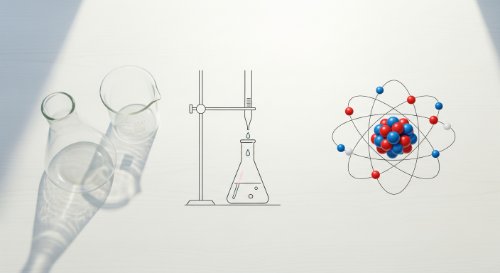Radioactivity - Chemistry (Undergraduate Foundation)
1
 CHM 101: General Chemistry IThis learning track delivers the complete NUC CCMAS curriculum for General Chemistry I. It is a comprehensive programme designed to build a robust, university-level foundation in modern chemistry. The track systematically covers all essential topics, from atomic theory, chemical bonding, and the states of matter, to the quantitative principles of stoichiometry, equilibrium, thermodynamics, and kinetics.
This programme is for first-year undergraduates in science, technology, engineering, and mathematics (STEM) faculties who are required to take CHM 101. It is also essential for any student or professional globally who needs a rigorous and complete foundation in first-year university chemistry for further study or career development.
This track delivers a full skill set in chemical theory and quantitative problem-solving. Graduates will be able to determine molecular structures, calculate reaction quantities, analyse the energetics and rates of reactions, and solve complex equilibrium problems. This programme provides the non-negotiable prerequisite knowledge for all subsequent chemistry courses and for any degree in the physical sciences, engineering, or medicine.
CHM 101: General Chemistry IThis learning track delivers the complete NUC CCMAS curriculum for General Chemistry I. It is a comprehensive programme designed to build a robust, university-level foundation in modern chemistry. The track systematically covers all essential topics, from atomic theory, chemical bonding, and the states of matter, to the quantitative principles of stoichiometry, equilibrium, thermodynamics, and kinetics.
This programme is for first-year undergraduates in science, technology, engineering, and mathematics (STEM) faculties who are required to take CHM 101. It is also essential for any student or professional globally who needs a rigorous and complete foundation in first-year university chemistry for further study or career development.
This track delivers a full skill set in chemical theory and quantitative problem-solving. Graduates will be able to determine molecular structures, calculate reaction quantities, analyse the energetics and rates of reactions, and solve complex equilibrium problems. This programme provides the non-negotiable prerequisite knowledge for all subsequent chemistry courses and for any degree in the physical sciences, engineering, or medicine.
This learning track delivers the complete NUC CCMAS curriculum for General Chemistry I. It is a comprehensive programme designed to build a robust, university-level foundation in modern chemistry. The track systematically covers all essential topics, from atomic theory, chemical bonding, and the states of matter, to the quantitative principles of stoichiometry, equilibrium, thermodynamics, and kinetics. This programme is for first-year undergraduates in science, technology, engineering, and mathematics (STEM) faculties who are required to take CHM 101. It is also essential for any student or professional globally who needs a rigorous and complete foundation in first-year university chemistry for further study or career development. This track delivers a full skill set in chemical theory and quantitative problem-solving. Graduates will be able to determine molecular structures, calculate reaction quantities, analyse the energetics and rates of reactions, and solve complex equilibrium problems. This programme provides the non-negotiable prerequisite knowledge for all subsequent chemistry courses and for any degree in the physical sciences, engineering, or medicine.
Course Chapters
1. Introduction1
This chapter provides the roadmap for the course. It introduces radioactivity as the process by which unstable atomic nuclei lose energy, and outlines the key topics of nuclear decay, fission, and fusion. Key learning objectives include: understanding the overall course structure and appreciating the role of nuclear chemistry in energy, medicine, and science.
Chapter lessons
1-1. Welcome
This lesson provides a brief overview of the course, outlining the key topics of radioactive disintegration, nuclear reactions, and the uses of radioisotopes.
2. Radioactive Disintegration34
This chapter covers the fundamental principles of radioactive decay. It details the common types of nuclear radiation and introduces the quantitative laws that govern the rate of decay. Key learning objectives include: identifying alpha, beta, and gamma radiation; balancing nuclear equations; and using the concept of half-life to perform decay calculations.
Chapter lessons
2-1. Nuclear stability
This lesson explains the concept of nuclear stability and why certain isotopes are radioactive, introducing the 'band of stability'.
2-2. Types of radiation
This lesson defines the three main types of radioactive decay: alpha decay, beta decay, and gamma emission, detailing the properties of each.
2-3. Half-life
This lesson introduces the concept of half-life as the time required for half of the radioactive nuclei in a sample to decay.
3. Nuclear Reactions3
This chapter introduces the powerful processes of nuclear fission and fusion. It covers the principles behind these energy-releasing reactions and their major applications. Key learning objectives include: defining and differentiating between nuclear fission and fusion; and describing the key applications of radioisotopes in medicine and industry.
Chapter lessons
3-1. Nuclear fission
This lesson defines nuclear fission as the process in which the nucleus of an atom splits into smaller parts, releasing a very large amount of energy.
3-2. Nuclear fusion
This lesson defines nuclear fusion as the process where two or more atomic nuclei are combined to form one or more different atomic nuclei and subatomic particles.
3-3. Uses of radioisotopes
This lesson explores the practical applications of radioisotopes, including their use as tracers in medical imaging, in radiation therapy, and for industrial purposes.
4. Conclusion2
This concluding chapter summarises the key concepts of nuclear chemistry. It reinforces the understanding of radioactive decay and the principles of nuclear reactions. This summary finalises the CHM 101 curriculum, providing the student with a complete foundation in first-year university chemistry.
Chapter lessons
4-1. Course summary
This lesson consolidates knowledge by reviewing the types of radioactive decay, the concept of half-life, and the principles of fission and fusion.
4-2. End of track
This final lesson provides a summary of the entire CHM 101 learning track and offers guidance on the subsequent courses for which the student is now prepared.